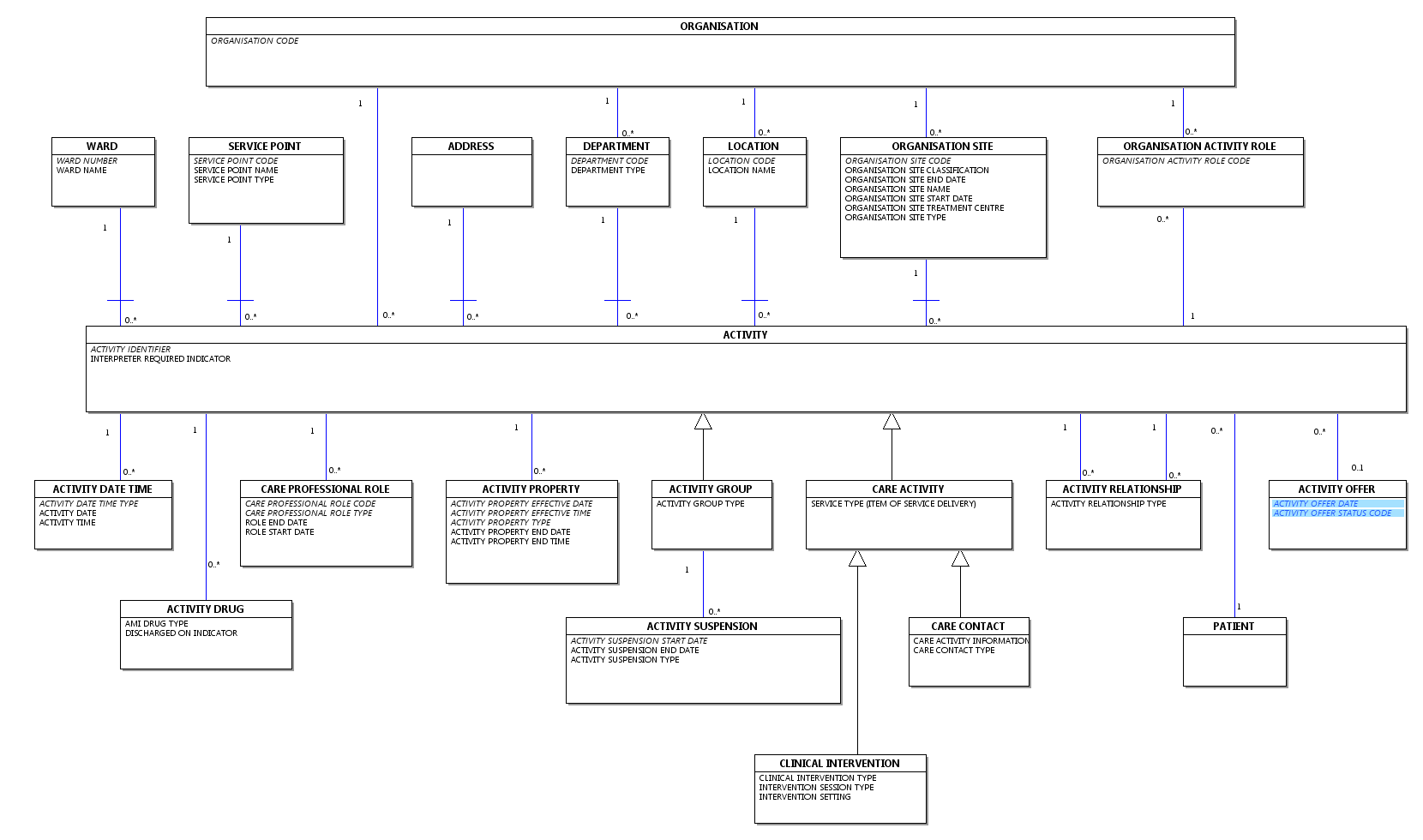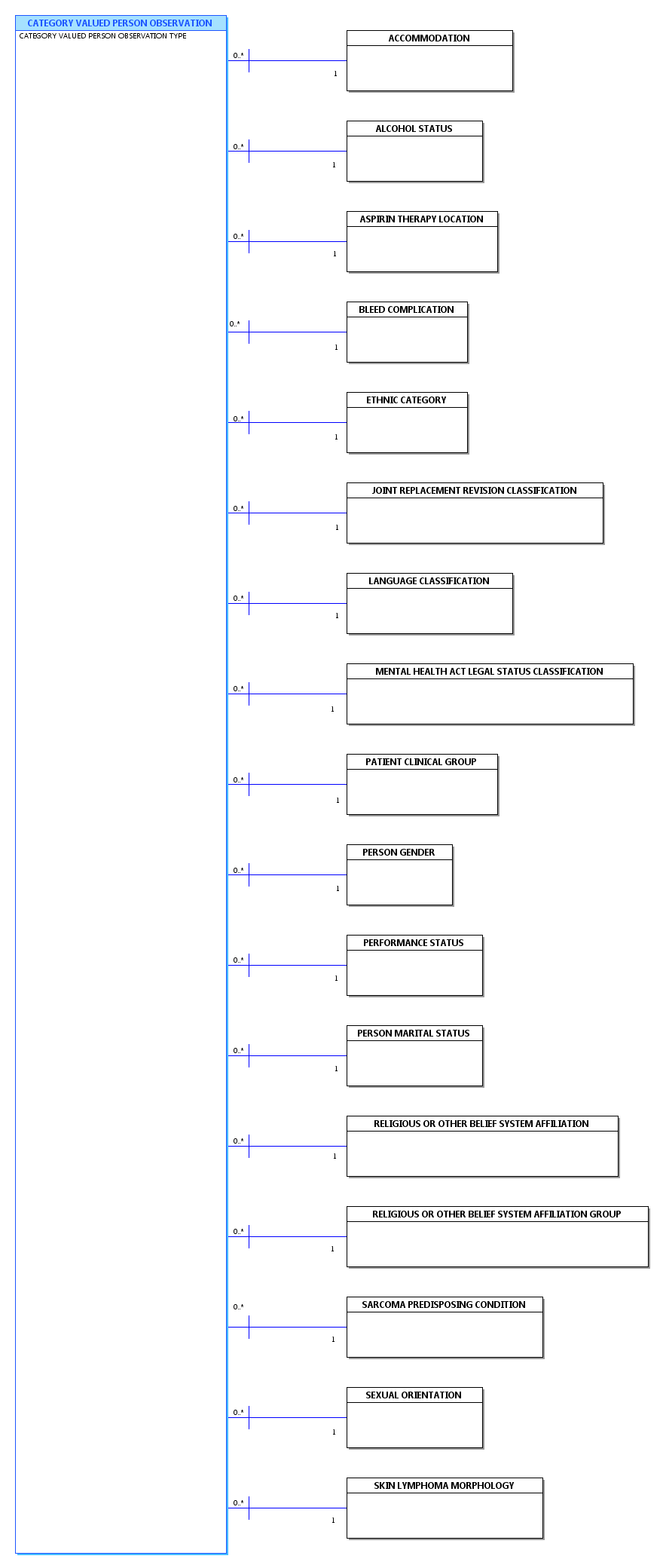NHS Connecting for Health
NHS Data Model and Dictionary Service
| Reference: | Change Request 1180 |
| Version No: | 1.0 |
| Subject: | Removal of Preparatory Items |
| Effective Date: | Immediate |
| Reason for Change: | Change to Data Standards |
| Publication Date: | 26 July 2010 |
Background:
The NHS Data Model and Dictionary Service are currently working with the Department of Health and Information Centre for Health and Social Care to develop a number of Data Sets.
During the business analysis stage, it has been identified that these Data Sets cover a number of common areas which are either not currently in the NHS Data Model and Dictionary or amendments are required to make the current information suitable for use in these Data Sets.
A number of Change Requests have been produced to add these common items into the NHS Data Model and Dictionary in preparation for these Data Sets.
This Change Requests removes the items that have been removed from the scope of the Data Sets. It also adds a NHS Business Definition for National Institute for Health and Clinical Excellence as it has been identified as a common item. The changes are detailed in the "Summary of changes" below.
The primary purpose is to introduce new items into the NHS Data Model and Dictionary to support the new data sets currently under development.
Summary of changes:
| Diagrams | |
| ACTIVITY | Changed Diagram |
| CATEGORY VALUED PERSON OBSERVATION | Changed Diagram |
| Supporting Information | |
| COMMON ASSESSMENT FRAMEWORK (FOR CHILDREN AND YOUNG PEOPLE) | Changed Description |
| LOOKED AFTER CHILD | Changed Description |
| NATIONAL INSTITUTE FOR HEALTH AND CLINICAL EXCELLENCE | New Supporting Information |
| Class Definitions | |
| ACTIVITY OFFER | Changed Attributes |
| ASSESSMENT TOOL | Changed Attributes |
| CATEGORY VALUED PERSON OBSERVATION | Changed Description |
| DISABILITY | Changed Attributes |
| EDUCATION | Changed Attributes |
| LANGUAGE CLASSIFICATION | Changed Attributes |
| REFUGEE OR ASYLUM SEEKER | Changed Attributes |
| Attribute Definitions | |
| CATEGORY VALUED PERSON OBSERVATION TYPE | Changed Description |
| LEARNING DISABILITY INDICATOR | Changed Description |
| PRIORITY TYPE | Changed Description |
| REFUGEE OR ASYLUM SEEKER INDICATOR | Changed Description |
| Date: | 26 July 2010 |
| Sponsor: | Ken Lunn, Director of Data Standards and Products, NHS Connecting for Health |
Note: New text is shown with a blue background. Deleted text is crossed out. Retired text is shown in grey. Within the Diagrams deleted classes and relationships are red, changed items are blue and new items are green.
Click here for a printer friendly view of this page.
Change to Supporting Information: Changed Description
This item is being used for development purposes and has not yet been assured by the Information Standards Board for Health and Social Care.
The Common Assessment Framework (For Children and Young People) is a standardised approach to conducting assessments of children's additional needs and deciding how these should be met. The Common Assessment Framework (For Children and Young People) is a key part of delivering frontline services that are integrated, and are focused around the needs of children and young people. It can be used by practitioners across children's services in England.
The Common Assessment Framework (For Children and Young People) promotes more effective, earlier identification of additional needs, particularly in universal services. It aims to provide a simple process for a holistic assessment of children's needs and strengths; taking account of the roles of parents, carers and environmental factors on their development. Practitioners are then better placed to agree with children and families about appropriate modes of support. The Common Assessment Framework (For Children and Young People) also aims to improve integrated working by promoting coordinated service provisions.
For further information on the Common Assessment Framework (For Children and Young People), see the Department for Children, Schools and Families website.For further information on the Common Assessment Framework (For Children and Young People), see the Department for Education website.
Change to Supporting Information: Changed Description
This item is being used for development purposes and has not yet been assured by the Information Standards Board for Health and Social Care.
A Looked After Child (also referred to as a Child Looked After) is a PERSON.
A Looked After Child is a child in the care of a Local Authority either:
- through a Care Order made by a court or
- voluntary agreement with their parent(s) to accommodate them.
They may be looked after:
- in a Children's Home,
- by foster carers, or
- other family members.
All Unaccompanied Asylum Seeking Children are also Looked After Children.
For further information on Looked After Children, see the Department for Children Schools and Families website.For further information on Looked After Children, see the Department for Education website.
Change to Supporting Information: New Supporting Information
This item is being used for development purposes and has not yet been assured by the Information Standards Board for Health and Social Care.
The National Institute for Health and Clinical Excellence (NICE) is the independent ORGANISATION responsible for providing national guidance on the promotion of good health and the prevention and treatment of ill health.
The National Institute for Health and Clinical Excellence produces guidance in three areas of health:
- public health - guidance on the promotion of good health and the prevention of ill health for those working in the NHS, local authorities and the wider public and voluntary sector;
- health technologies - guidance on the use of new and existing medicines, treatments and procedures within the NHS;
- clinical practice - guidance on the appropriate treatment and care of people with specific diseases and conditions within the NHS.
Further information on the National Institute for Health and Clinical Excellence, see the National Institute for Health and Clinical Excellence website.
This supporting information is also known by these names:
| Context | Alias |
|---|---|
| shortname | NICE |
Change to Class: Changed Attributes
| K | ACTIVITY OFFER DATE | |
| K | ACTIVITY OFFER STATUS CODE |
Change to Class: Changed Attributes
| ASSESSMENT TOOL TYPE |
Change to Class: Changed Description
This item is being updated for development purposes and the changes have not yet been assured by the Information Standards Board for Health and Social Care.
A type of PERSON PROPERTY.
Observations made regarding a PERSON. These observations do not include information about a treatment or intervention.
CATEGORY VALUED PERSON OBSERVATION allows coded classifications of observations about a PERSON and includes:
- ACCOMMODATION
- ALCOHOL STATUS
- ASPIRIN THERAPY LOCATION
- BLEED COMPLICATION
- CONTRACEPTION
- DISABILITY
- DISABILITY SEVERITY
- ETHNIC CATEGORY
- JOINT REPLACEMENT REVISION CLASSIFICATION
- LANGUAGE CLASSIFICATION
LANGUAGE FLUENCY- MENTAL HEALTH ACT LEGAL STATUS CLASSIFICATION
- PATIENT CLINICAL GROUP
- PERFORMANCE STATUS
- PERSON GENDER
- PERSON MARITAL STATUS
- REFUGEE OR ASYLUM SEEKER
- RELIGIOUS OR OTHER BELIEF SYSTEM AFFILIATION
- RELIGIOUS OR OTHER BELIEF SYSTEM AFFILIATION GROUP
- SARCOMA PREDISPOSING CONDITION
- SEXUAL ORIENTATION
- SKIN LYMPHOMA MORPHOLOGY
Note: MEASURED PERSON OBSERVATION allows for recording of measurements about a PERSON and OTHER PERSON OBSERVATION is where the PERSON states, for example, when they first experienced symptoms, the number of days on which alcohol has been consumed etc.
Change to Class: Changed Attributes
| LEARNING DISABILITY INDICATOR | ||
| PERCEIVED DISABILITY CODE | ||
Change to Class: Changed Attributes
| SPECIAL EDUCATIONAL NEED TYPE |
Change to Class: Changed Attributes
| LANGUAGE CLASSIFICATION CODE | ||
Change to Class: Changed Attributes
| REFUGEE OR ASYLUM SEEKER INDICATOR | ||
| UNACCOMPANIED ASYLUM SEEKING CHILD INDICATOR |
Change to Attribute: Changed Description
This item is being updated for development purposes and the changes have not yet been assured by the Information Standards Board for Health and Social Care.
A classification of a CATEGORY VALUED PERSON OBSERVATION.
National Codes:
Change to Attribute: Changed Description
This item is being used for development purposes and has not yet been assured by the Information Standards Board for Health and Social Care.
An indication of whether a PERSON has a Learning Disability. This may be derived from PATIENT DIAGNOSIS or collected explicitly.
A Learning Disability may be a:
RegisteredDISABILITY, which is recorded usingREGISTERED DISABILITY CODEif thePERSONis registered disabled; or- Perceived DISABILITY, which is recorded using PERCEIVED DISABILITY CODE if the clinician considers the PATIENT to have a Learning Disability but it is not formally registered.
National Codes:
| Y | Yes |
| N | No |
Change to Attribute: Changed Description
This is the priority of a request for services; in the case of services to be provided by a CONSULTANT, it is as assessed by or on behalf of the CONSULTANT.
Priority Type 'Urgent' should be used where the request for services is defined as clinically urgent, but it does not fall under the criteria for 'Two Week Wait' (see below).
Priority Type 'Two Week Wait' should be used where either:
the request for services meets the criteria for an urgent GENERAL PRACTITIONER referral for suspected cancer. These referrals should be made in accordance with the National Institute for Health and Clinical Excellence (NICE) clinical guidelines on referral for suspected cancer. See NICE guidance These referrals should be made in accordance with the National Institute for Health and Clinical Excellence (NICE) clinical guidelines on referral for suspected cancer. For further information, see the NICE guidance
or
the PATIENT has been referred urgently for breast symptoms, but the referral does not meet the criteria for urgent GENERAL PRACTITIONER referrals for suspected cancer
National Codes:
| 1 | Routine |
| 2 | Urgent |
| 3 | Two Week Wait |
Change to Attribute: Changed Description
This item is being updated for development purposes and the changes have not yet been assured by the Information Standards Board for Health and Social Care.
An indication of whether a PERSON is a REFUGEE OR ASYLUM SEEKER.
National Codes:
| a. | Yes |
| b. | No |
For enquiries about this Information Standards Notice, please email datastandards@nhs.net



